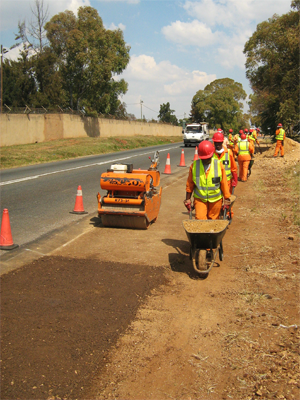
The declining physical condition of our nation’s roadways is well documented. We have successfully litigated highway defect cases across the country, including edge drop-off cases in which the roadway’s edge was not properly constructed.
Every four years the American Society of Civil Engineers (ASCE) issues a report card to depict the condition and performance of America’s infrastructure, assigning letter grades in the form a school report card. Along with the D+ grade, the ASCE cited a backlog of overdue maintenance and a pressing need for modernization and long-term funding.
Defective highway shoulders have been cited as a major cause of severe accidents involving injuries and fatalities on roadways nationwide. A common cause of highway shoulder accidents is pavement edge drop-offs, which occur when there are uneven height differences between the travel lane and shoulder. Several issues routinely come up in highway shoulder defect cases and offers practical tips for litigating these types of cases.
Characteristics of a Shoulder Defect Accident
A highway shoulder is defective if there is an unsafe drop-off between the edge of the roadway pavement and the shoulder. A pavement edge drop-off is a “vertical elevation difference between two adjacent roadway surfaces.”
According to the Federal Highway Administration (FHWA), approximately 11,000 people are injured and about 160 die annually in crashes related to unsafe pavement edges, resulting in a cost of $1.2 billion. Pavement edge drop-offs are especially unsafe because the uneven height differences between surfaces can decrease vehicle stability and hinder a driver’s ability to handle a vehicle.
When vehicles leave the travel lane and encounter a defective highway shoulder, usually the tire slips off the pavement and gets wedged or restricted by the pavement edge. Drivers are often surprised when this happens and tend to overcorrect as they attempt to return to the travel lane, causing the vehicle tires to “scrub” against the pavement edge and preventing the vehicle from returning onto the pavement.
The steering angle required to return the front wheels to the pavement and overcome the change in elevation is greater than what would typically be required to make the same turn on an aligned pavement. As a result, drivers tend to lose control of the vehicles, cross the centerline and, in some cases, collide with oncoming traffic.
Unsafe Highway Construction Practices
One of the most common tort liability lawsuits filed against state agencies and construction contractors involves cases in which pavement edge drop-off was a major contributing factor to a crash.[i] Often, motorists will encounter unsafe pavement edge drop-offs in construction zones involving highway resurfacing. These pavement edge drop-offs form when the contractor or responsible party fails to provide a proper transition to the shoulder. They can be particularly dangerous at nighttime because the dark pavement is difficult for drivers to see.
In one case Langdon & Emison handled, our client was severely injured in an accident when her right front tire dropped off a 4-inch asphalt ledge, which had been left by the defendant during the process of resurfacing the highway. Our client lost control of the vehicle and swerved into the opposite lane of traffic, which was still under construction and was about 1-inch lower in height than the original lane in which she was traveling.
When our client tried to return the vehicle to her lane of traffic, she lost control and the vehicle overturned two times. She sustained severe injuries that ultimately rendered her quadriplegic.
Our firm also handled a case in Stephenson County, Ill., where a driver approached a pavement edge drop-off of about 3 inches, but no work was being done. There were no workers or machinery in the area, and no edge lines or signage delineated the location of the drop-off. When our client hit the drop-off, his vehicle first wobbled and then left the roadway, flipping end-over-end several times. He suffered severe and permanent injuries to his entire body as well as a traumatic brain injury.
Crashes caused by pavement edge drop-offs are two to three times more likely to be fatal. Additional causes of pavement edge drop-offs include pavement edge-breaking as well as erosion and excessive wear, which can cause the shoulder material to migrate away from the pavement edge.
Identifying the Defect
Drivers who have been involved in an accident where a defective highway shoulder or unsafe pavement edge-drop off could be at fault should contact a law firm experienced in defective roadway cases. Thorough case evaluation and assessment of a highway shoulder defect is a critical first step in the litigation process. An experienced attorney must establish a design, construction or maintenance defect existed and the nature and location of the accident was a result of the defect. Key steps include:
-
Investigating the scene of the accident with qualified experts.
-
Evaluating the shape and height of the drop-off in relation to federal guidelines.
-
Photographing and documenting roadway characteristics, including everything from the driver’s perspective (e.g., all signs, pavement/edge markings, speed limits, skid marks, etc.).
-
Obtaining all documents from the police investigation as well as photographic records and maintenance records from the local or state department of transportation.
Highway shoulders are intended to be safety devices that protect the traveling public. The entities that own, construct and maintain America’s roadways have a responsibility to ensure they are safe and perform as intended.
Sources
Hallmark, Veneziano, McDonald, et al. “Safety Impacts of Pavement Edge Drop-offs.” Prepared for the Foundation for Traffic Safety in cooperation with the U.S. Department of Transportation Federal Highway Administration. September 2006.
FHWA Resource Center Safety & Design Team. (accessed on Oct. 6, 2014).
TranSafety, Inc. “Legal Problems: The Liabilities of Roadside Maintenance.” Road Management & Engineering Journal. 1997.
Hallmark, Veneziano, McDonald, et al. “Safety Impacts of Pavement Edge Drop-offs.” Prepared for the Foundation for Traffic Safety in cooperation with the U.S. Department of Transportation Federal Highway Administration. September 2006.
[i] Hallmark, Veneziano, McDonald, et al. “Safety Impacts of Pavement Edge Drop-offs.” Prepared for the Foundation for Traffic Safety in cooperation with the U.S. Department of Transportation Federal Highway Administration. September 2006.


